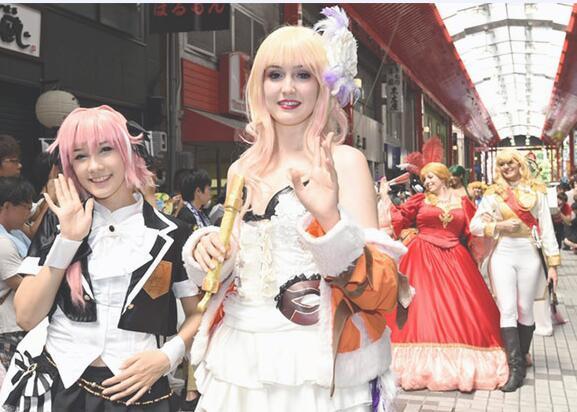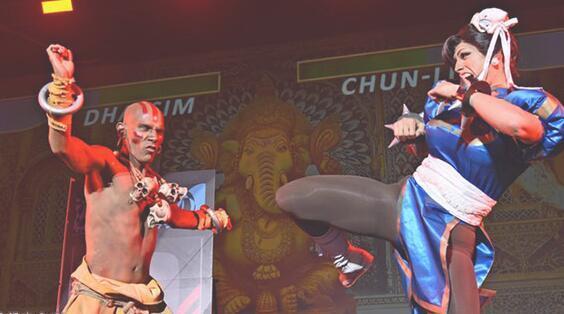The Cosplay (role-playing) culture is spreading throughout Japan and abroad. In addition to the large number of European and American countries with Cosplay enthusiasts, fans of emerging market countries such as Asia are also growing with the help of economic growth. Ideas such as “I want to change” and “I want to share (anime) world view” have become the driving force behind the Cosplay boom. The spread of the Cosplay culture also helps promote international exchanges and Japan’s consumption growth.

“The world champion is the Mexican team!” On the evening of August 15, in the Aichi Sports Hall in Nagoya City, the results of the competition were just announced, and there was a warm applause and cheers in the venue. This is the final of the “World COSPLAY Summit (WCS)” held every year in Nago.
The executive director of the contest, Xiao Li Dewan, said, “This year, African countries participated in South Africa for the first time, and the number of participating countries and regions increased to 38 (the two countries were absent on the same day). The teams selected from the five continents competed for the championship on the same stage.”
The teams of various countries have changed and performed on the theme of Japanese anime and games such as “Ghost in the Shell”, “Warrior’s Warriors”, “Black Deacon”, “Goddess of Difference 5”, “Doraemon” . There are also many teams who introduce themselves in fluent Japanese.
The Mexican team that won the championship reproduces the confrontation between the yoga practice and the female fighter in the fighting game “Street Fighter” with excellent physical ability. Eduardo of Mexico said with excitement, “I like and respect Japanese culture very much. Japan is my country.”
The atmosphere is not only the final venue. At the venue of the event, “Oasis 21”, Cosplay enthusiasts (Cosplayer) and photographers who come in various costumes come and go. Popular Cosplay enthusiasts lined up with more than 30 people in front. Cosplay enthusiasts also performed parades in Nagoya City to communicate with more people.
This competition is regarded as the largest Cosplay event for global Cosplay fans. Including qualifiers held in various countries and regions, more than 2 million people participated in 2017, and the scale is expanding year by year.

Looking back at the last 14 contests in the finals, Italy and Brazil won the most championships, each winning three times. Followed by two times in Japan and Mexico. In the field of Cosplay, developed countries such as Italy, France, and Japan were eye-catching, but in recent years, the presence of emerging market countries such as Brazil, Russia, China, Mexico, and Asia has rapidly increased.
Xiao Li Demao, executive chairman of the contest, said: “As the economic growth momentum shifts from developed countries to emerging market countries, the Cosplay boom has also spread. It is still a country with a lot of fans.” With the popularity of the Internet, the latest information originating in Japan was spread to the world in real time, which also promoted the Cosplay boom.
In addition to Nagoya, the “Cosplay Holy Land” has also appeared in other parts of Japan. For example, in Tokyo, Akihabara and Ikebukuro, where there are a lot of animation game sales stores and maid cafes, are the main places where Cosplay fans gather.
Japan’s YUZAWAYA Trading Co., Ltd. operates 61 “YUZAWAYA” handicraft stores nationwide. This company opened a new store in Ikebukuro five years ago, and set up a special area for fabrics, wigs and cosmetics used in Cosplay sales. Customers from Japan, Europe, North America, Asia, South America and the Middle East have seen an increase in shopping, and YUZAWAYA is actively using social networking sites (SNS) and mobile apps to promote information for Cosplay enthusiasts.
A Chinese girl in her 20s who came to the store said, “I especially like Japanese anime, so I came to Japan. YUZAWAYA is very famous in our Cosplay circle. I bought materials that I can’t buy overseas, so happy.” .
According to the Japanese Yano Economic Research Institute, the domestic market size of Cosplay apparel in Japan is approximately 35 billion yen (2017). Although the sales of Halloween transvesting activities at the end of October accounted for the majority, the inbound consumption of foreign tourists is increasing significantly.
On the one hand, Cosplay has also had an impact on the Japanese fashion industry. San Shulang, a designer at the Tokyo Fashion Show, has released works that reflect Japanese “home culture” such as anime and Cosplay, and has received great attention. ITOCHU FashionSystem said, “Cosplay has begun to exert influence as a trend that cannot be ignored.”
In the context of Japan’s apparel consumption continues to struggle, Cosplay may become a catalyst to activate the market.
